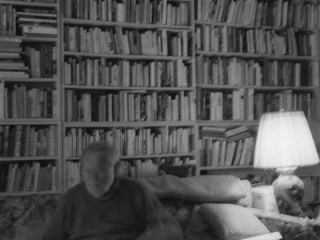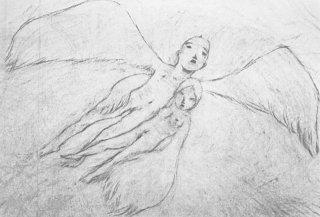Date: 2 November 2003 | Season: London Film Festival 2003 | Tags: London Film Festival
FILM AS A SUBVERSIVE ART
Sunday 2 November 2003, at 7pm
London National Film Theatre NFT3
Paul Cronin, Film as a Subversive Art: Amos Vogel and Cinema 16, UK, 2003, 56 min
Speaking recently about the myriad dangers facing humanity, director-provocateur Werner Herzog cited ‘the lack of adequate imagery’ as one of the most troubling. It’s a view Amos Vogel would surely endorse. As one of America’s most important curators, historians and festival directors, his influence on artists, experimental and underground film cannot be overstated. Born in Austria in 1922 but resident in New York since 1938, Vogel created the path-breaking film society Cinema 16 in 1947, introducing a continent to previously unseen worlds of experience. 20 years on, he established the New York Film Festival and with his eye-changing book ‘Film as a Subversive Art’, penned a revolutionary analysis of the moving image. Now, in Cronin’s valuable tribute to an extraordinary man and his times, Vogel delivers a series of compelling and entertaining reflections on a life lived in the passionate belief that film has a fundamental, radical and ethical role to play in society. Required viewing for anyone who believes cinema matters. Really matters. (Gareth Evans)
followed by
Exhibitionism: Subversive Cinema and Social Change
Following the screening of Film As A Subversive Art: Amos Vogel and Cinema 16 we will be staging a panel discussion focusing on some of the key issues raised in the film.
PROGRAMME NOTES
FILM AS A SUBVERSIVE ART
Sunday 2 November 2003, at 7pm
London National Film Theatre NFT3
FILM AS A SUBVERSIVE ART: AMOS VOGEL AND CINEMA 16
Paul Cronin, UK, 2003, video, colour, sound, 56m
An hour-long profile of Amos Vogel, 82-year old New York resident and Austrian emigré, founder of the New York Film Festival and the Cinema 16 film society.
In 1947, Amos Vogel established a film club in New York called Cinema 16, the most important and influential film society in American history. At its height it boasted thousands of members, inspired a nationwide network of smaller film societies, and gave birth to the very rich tradition of post-war film culture that still exists in the United States. More than a decade before the father of modern ‘independent’ cinema – John Cassavetes – even picked up a camera, Vogel was bringing to a mass audience new ways of looking at world cinema.
The audiences of Cinema 16 were presented with a wide range of film forms, often programmed so as to confront – and sometimes to shock – conventional expectations, including works of the avant-garde, documentaries of all kinds, experimental animation, and foreign or independent features and shorts not in distribution in the United States. From the very beginning Vogel was determined to demonstrate that there was an alternative to industry-made cinema. Initially concentrating on non-fiction, he became the first programmer to show the works of Polanski, Cassavetes, De Palma, Kluge, Oshima, Ozu, Polanski, Rivette and Resnais (among many others) to American audiences. Vogel saw himself as a special breed of educator, using an exploration of cinema history and current practice not only to develop a more complete sense of the myriad experiences film culture had to offer, but also to invigorate the potential of citizenship in a democracy, and cultivate a sense of global responsibility.
Film as a Subversive Art: Amos Vogel and Cinema 16 tells the story of Cinema 16 through a vivid compilation of images and sounds, including a selection of newly filmed interviews with Amos Vogel (erudite and charismatic on-camera) and historian Scott MacDonald, author of a recent book about Vogel and Cinema 16. Vogel is filmed in various New York locations that are pertinent to the history of Cinema 16 and to New York film culture in general. There are rostrum shots of some of the photographs and beautifully designed catalogues and leaflets from Vogel’s extensive Cinema 16 archive. The film also contains excerpts from a selection of films screened at Cinema 16 between 1947 and 1963, including Roman Polanski’s Two Men and a Wardrobe, the infamous Nazi propaganda film The Eternal Jew, and the only film made by legendary New York press photographer Weegee. —Paul Cronin
Back to top
Date: 2 November 2003 | Season: London Film Festival 2003 | Tags: London Film Festival
UNKNOWN PARTS OF THE WORLD
Sunday 2 November 2003, at 9pm
London National Film Theatre NFT3
Thomas Comerford, Figures in the Landscape, USA, 2002, 11 min
Grainy, undefined images shot with a pinhole camera accompany recitations of texts tracing the history of suburban housing from the rudimentary dwellings of Native Americans and the early settlers. An inquiry into human interaction with the landscape and notions of land development.
David Gatten, Secret History of the Dividing Line, USA, 2002, 20 min
Text-based, hand-processed treatment of Colonel William Byrd II’s 1728 expedition to settle disputes on the boundary between two American states, as chronicled in his ‘Histories of the Dividing Line Betwixt Virginia and North Carolina’.
Ben Russell, Terra Incognita, USA, 2002, 10 min
‘A lenseless film, whose cloudy images produce a memory of history. Ancient and modern explorer’s texts on Easter Island are garbled together by a computer narrator, resulting in a forever repeating narrative of discovery, colonialism, loss and departure.’
Phil Solomon, Psalm III: Night of the Meek, USA, 2002, 23 min
Obscure, ghostly faces emerge from a degraded, murky image, not through animation, but chemical and optical treatments of re-photographed and original material. A transcendental nightmare vision based on the legend of the golem. ‘A Kindertotenlieder in black and silver, on a night of gods and monsters.’
Naoyuki Tsuji, A Feather Stare at the Dark, Japan, 2003, 17 min
Pencil animation telling the mystical pre-history of the world through surreal, transformational drawings which depict the struggle between good and evil at the origins of evolution.
PROGRAMME NOTES
UNKNOWN PARTS OF THE WORLD
Sunday 2 November 2003, at 9pm
London National Film Theatre NFT3
FIGURES IN THE LANDSCAPE
Thomas Comerford, USA, 2002, 16mm, colour, sound, 11 min
In making films with a pinhole camera, returning to a technology that predates the invention of cinema, Thomas Comerford uses consciously archaic means to comment on cinema’s technology and on technological progress in general. The fragile, fuzzy images that result from the replacement of the camera lens by a tiny hole have a wispy, almost virtual quality that refers back to the camera obscura of the Renaissance. Figures in the Landscape, set in Schaumburg, one of the Chicago area’s more sprawling suburbs, includes town maps and plans as well as images of people standing amid empty, almost soul-less spaces. Comerford uses found texts to describe the nature of suburban development and the way high-tech homes have replaced the more ‘primitive’ dwellings of Indians and early European pioneers, thus comparing his pinhole technique with early residents’ primitive homes on the one hand while the slicker and higher-tech cinema which he eschews is implicitly paralleled to the new homes of Schaumburg on the other. Comerford’s ironic point about ‘progress’ is reinforced when we hear about the Indians’ use of trees as trail markers while seeing a giant pole, and hear about early pioneer homes while seeing a particularly vulgar oversized modern dwelling. —Fred Camper
SECRET HISTORY OF THE DIVIDING LINE
David Gatten, USA, 2002, 16mm, b/w, silent, 20 min
When using tape to make a splice the cut pieces of film are placed end to end and the tape itself covers the gap: it is a band-aid and a bridge. But as the splice ages a line becomes visible; eventually the adhesive dries and the connection dissolves. When making a cement splice, there is more violence involved. The films are not placed end to end but instead are crushed into one another. Frames are lost, emulsions are scraped. But the well made splice is strong: in fact, it is permanent. Unlike tape, there is no going back. And it leaves a mark – a line – covering a third of one of the frames. A splice marks difference and defines duration. To suppress that mark is to pretend that we will live forever. Instead, take your splicer and knock the blade out of alignment. Forego the B-roll in favour of a single strand of faith. Hold your breath and count the hours since you were last together. Blow softly on a wet face and watch the smile form. Float your hand across the surface and find all the words you need. Unfold the splicer and separate your image from your dream; you will feel bound, as if tied down until you are fully awake. Only then will you know for sure: this may not be final but it is definite. The landscape you see can change only when you pass through it. Regard your new object: a union: silent, tiny and bright. Paired texts as duelling histories; a journey imagined and remembered; 57 mileage markers produce an equal number of prospects. The latest in a series of films about the division of landscapes, objects, people, ideas and the Byrd family of Virginia during the early 18th century. —David Gatten
TERRA INCOGNITA
Ben Russell, USA, 2002, 16mm, colour, sound, 10 min
In the in-between of history and memory lies the Unknown Part of the World. I have seen it, however briefly – projected out in front of my eyes like some old-timey silent film. I knew the place immediately, what with its rusted factories , fallen statues , floating figurines, but the image was lost as soon as the reel ran out. Played it back. Mapped out the sounds. Grabbed a camera, a makeshift recording device, played it back. And again. Each time I cobbled together a newer world, cut and spliced out of words and images from this one; but they seem to accumulate, these geographies – each one charted proposes an entirely different set of islands , continents , planets moving about just beyond the horizon. Therein lies the joy and terror; and throughout all of it, this camera here is but a minor tool in sifting through this shifting terrain. —Ben Russell
PSALM III: NIGHT OF THE MEEK
Phil Solomon, USA, 2002, 16mm, b/w, sound, 23 min
It is Berlin, November 9, 1938, and, as the night air is shattered throughout the city, the Rabbi of Prague is summoned from a dark slumber, called upon once again to invoke the magic letters from the Great Biij that will bring his creatures made from earth back to life, in the hour of need. A Kindertotenlieder in black and silver, on a night of gods and monsters …
In Germany, Before the War:
I’m looking at the river,
but I’m thinking of the sea,
thinking of the sea,
thinking of the sea …
I’m looking at the river,
but I’m thinking of the sea,
thinking of the sea,
thinking of the sea … —Phil Solomon
A FEATHER STARE AT THE DARK
Naoyuki Tsuji, Japan, 2003, 16mm, b/w, sound, 17 min
This is the tale in the pre-world before bearing our earth. There is the world in chaos with the existence of the force of the good and evil that has interfered with each other. And it is going to build the chance of birth in the New World. The pre-world is carrying out a growth expansion at the same time, going to decay. However, the force of the decay sets up birth in the coming world. —Naoyuki Tsuji
Back to top

